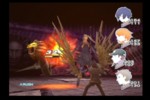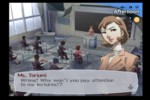Shin Megami Tensei: Persona 3 not only meets the high standards set for the series and its subsidiaries, but raises the bar substantially.
From the moment the introductory video starts to play, it is readily apparent that this is not a typical Japanese role-playing Game. Instead, Persona 3 could best be described as a meshing together of two very different genres: a dungeon crawler, and a school/dating sim. Even that, however, really does not do justice to how well the game presents every single aspect of its gameplay and presentation.
Even Persona 3's storyline is atypical. The player starts off as a transfer student to Gekkoukan high, having just stepped off of the train. Not so strange yet? Well, immediately upon entering his dorm, he's approached by a strange boy who has apparently been waiting for him to sign a contract; the boy says it's a normal thing, just saying the player takes responsibility for his/her actions. From then on, the story has two rather divergent arcs that are ingeniously linked together. The first is that of the life of the main character as he progresses through a year at Gekkoukan High. The second part of the story has players leading the protagonist and a few of his dormmates through a labyrinthian tower called Tartarus during the Dark Hour. The Dark Hour is an Hour between 12:00 and 12:01 A.M. during which normal people are locked into coffins asleep and only a few people are active. Also during this time, demons have nearly free reign over the world, or at least that in and around Tartarus.
Yes, the two paths that come together during the story are quite different, but Persona 3 not only makes them work, it makes them work so well that players will often have trouble deciding which they want to do more: spend time training and advancing ever further in Tartarus, or focus instead on schoolwork and improving social links.
 |
| The enemies are a bit... strange. |
Social links are one of the most impressive aspects of the game. Once the first one is established, players are told that establishing more links and nurturing them will help them increase the power of their Persona. While this works at first for the purpose of establishing motivation to use the system, it is the depth of the social links that will keep players enthralled. Each social link is established with either one person or a group of people that players will eventually grow to know, and most likely, to like. Some of them are so well done that players will feel honestly upset with themselves for not spending time with, say, their best friend in lieu of going to Tartarus or training with their sports club. Nearly every person or group presented in the social link system is extremely well done. They have stories to tell, secrets to share, and players get to interact on a very real level with them. It is amazing how well done this system is, especially since it isn't even close to the main part of the game.
The game mostly consists of time spent after school and time spent in Tartarus. Time during school is mainly skipped over. The only major things that happen during the school day itself are having people from social links ask to hang out during lunchtime, having the occasional pop quiz, and exams. The best thing about the school day is how real to life it seems. Players honestly have to pay attention to teacher's speeches or else they'll look like a fool when asked a question in class. Friends--mainly Junpei--will ask for answers when called upon unawares. After school, players can go to a number of locations, though unfortunately exploration in the city is very limited. What players do after school, however, is a large part of how they can improve the main character's stats. Interacting with others through the social link system will improve the power of their Persona, and doing other activities such as studying can improve character's academics, charm, or courage. It is hard to get across how many options there truly are in the game. Players will really have a hard time at many points in the game trying to decide what exactly they want to do, who they want to hang out with, and what is most important to them.
Players should visit Tartarus quite often. Tartarus is, as mentioned before, a tower in which many demons reside. Apparently the main character and his dormmates have been brought together because they are some of the few humans who realize that the Dark Hour is ocurring. Because of this, and their ability to summon Persona--other aspects of themselves--in battle, they must explore Tartarus to discover the reasons behind the Dark Hour and the demons infestation. Exploring Tartarus involves questing through literally hundreds of floors killing demons, fighting bosses, gaining new Personae, and carrying out sidequests. This of course involves a lot of battling. Thankfully, the battle system in Persona 3 is as superb as the rest of the game.
Battles are turn-based affairs; however, players only control the main character. This could bring doubt to some people's minds, but the AI for the other characters is superbly done. For example, once they find out an enemy is resistant to a spelltype, they don't use it any more, without players telling them not to. They also are great about healing other characters when needed. Anyway, the battles in Persona 3 have all the standard options, with the addition of Personae. The main character is capable of summoning different Personae, which essentially act both as his magic and as stat boosts. Depending on the Persona equipped, the main character will have different strengths and weaknesses. Furthermore, discovering and attacking the enemy's weakness is the key to victory. Hitting the enemy's weak point (for massive damage) will cause them to be downed, and set up the possibility of an All-Out Attack. These attacks essentially amount to a free ass-kicking session on the enemy, during which all the characters run in and hammer on the enemy for a short time. Because of this, players' strategies will almost certainly revolve around hitting weak points in the enemy's defenses. The battle system is highly strategic, and actually works very quickly. The challenge level is high, but not as high as some entries in the Shin Megami Tensei series, notably Nocturne.
One final major system in the game is the ability to create and fuse Personae. After getting to a certain point in the game, players can store the Personae they have in order to recall them later, and use them to fuse with others. These fusions can be two or three-way and generally unlock much stronger Personae than the player could acquire normally. It's very well done and highly accessible.
 |
| Oh, I don't know, because I'm trying to save you from demons you don't know exist? |
Aurally, Persona 3 does not fail to impress. The voice acting is nothing short of superb, with every character sounding exactly as one would expect him/her to. Furthermore, the music is wonderful. It was shocking at first to hear hip-hop themes infused into standard Shin Megami Tensei typed melodies, but after hearing it for a while, it really works. The music is as great as the rest of the game.
Persona 3 doesn't fail to impress graphically either. The anime scenes, while rather sparse, are fantastic, and its in-game graphics are also great. The style shown throughout the Shin Megami Tensei series and offshoots is readily apparent, and the game looks sharp, sleek, and smooth throughout. The effects in battle are also well done.
Shin Megami Tensei: Persona 3 is a role-playing experience in a realm of its own. Its mature themes, superb production values, awesome battle system, and phenomenal storyline set it in a class of its own. Few RPGs could hope to do what Persona 3 does easily: make the player care about the people in the game.